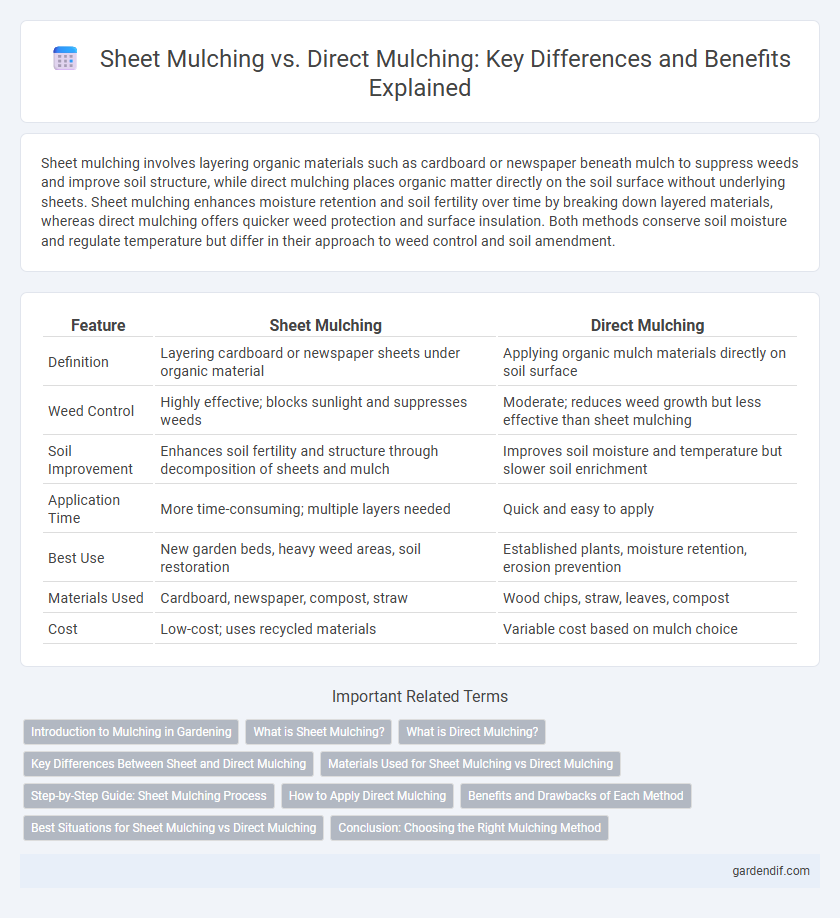
Sheet mulching vs Direct mulching Illustration
Sheet mulching involves layering organic materials such as cardboard or newspaper beneath mulch to suppress weeds and improve soil structure, while direct mulching places organic matter directly on the soil surface without underlying sheets. Sheet mulching enhances moisture retention and soil fertility over time by breaking down layered materials, whereas direct mulching offers quicker weed protection and surface insulation. Both methods conserve soil moisture and regulate temperature but differ in their approach to weed control and soil amendment.
Table of Comparison
| Feature | Sheet Mulching | Direct Mulching |
|---|---|---|
| Definition | Layering cardboard or newspaper sheets under organic material | Applying organic mulch materials directly on soil surface |
| Weed Control | Highly effective; blocks sunlight and suppresses weeds | Moderate; reduces weed growth but less effective than sheet mulching |
| Soil Improvement | Enhances soil fertility and structure through decomposition of sheets and mulch | Improves soil moisture and temperature but slower soil enrichment |
| Application Time | More time-consuming; multiple layers needed | Quick and easy to apply |
| Best Use | New garden beds, heavy weed areas, soil restoration | Established plants, moisture retention, erosion prevention |
| Materials Used | Cardboard, newspaper, compost, straw | Wood chips, straw, leaves, compost |
| Cost | Low-cost; uses recycled materials | Variable cost based on mulch choice |
Introduction to Mulching in Gardening
Sheet mulching involves layering organic materials such as cardboard or newspaper beneath mulch to suppress weeds, retain moisture, and improve soil fertility through decomposition. Direct mulching applies organic matter like wood chips or straw directly onto the soil surface, providing immediate insulation and moisture conservation without the initial layering step. Both methods enhance soil health and plant growth but differ in preparation effort and decomposition speed.
What is Sheet Mulching?
Sheet mulching is an eco-friendly gardening technique that involves layering organic materials like cardboard or newspaper over soil before adding mulch to suppress weeds and improve soil health. This method promotes moisture retention, enhances soil fertility, and reduces erosion by creating a nourishing barrier. Unlike direct mulching, sheet mulching actively breaks down materials to enrich the soil structure over time, fostering sustainable plant growth.
What is Direct Mulching?
Direct mulching involves applying organic materials such as wood chips, straw, or compost directly onto the soil surface to suppress weeds, retain moisture, and improve soil structure. This method promotes soil health by enhancing microbial activity and nutrient cycling without the need for a weed barrier layer. Compared to sheet mulching, direct mulching is simpler, faster to implement, and ideal for areas with minimal weed pressure.
Key Differences Between Sheet and Direct Mulching
Sheet mulching involves layering organic materials like cardboard or newspaper beneath mulch to suppress weeds and improve soil structure, while direct mulching places organic matter directly on the soil surface. Sheet mulching enhances moisture retention and soil aeration more effectively by creating a protective barrier, whereas direct mulching offers quicker nutrient release and easier application. Key differences include weed suppression efficiency, soil health benefits, and the time required for decomposition and nutrient cycling.
Materials Used for Sheet Mulching vs Direct Mulching
Sheet mulching utilizes layers of organic materials such as cardboard, newspaper, compost, and mulch to create a weed-suppressing barrier that enriches soil over time. In contrast, direct mulching involves applying a single type of mulch, such as wood chips, straw, or leaves, directly onto the soil surface without layering. The choice of materials in sheet mulching promotes decomposition and soil health, whereas direct mulching primarily focuses on moisture retention and temperature regulation.
Step-by-Step Guide: Sheet Mulching Process
Sheet mulching involves layering organic materials such as cardboard or newspaper directly onto the soil, followed by a thick layer of compost and mulch to suppress weeds and enrich soil health. Begin by clearing the target area of large debris, then lay down overlapping sheets of cardboard or newspaper to ensure complete coverage, preventing weed growth. Top the sheets with 3-6 inches of compost to introduce beneficial microbes, and finish with a 3-6 inch mulch layer like wood chips or straw to retain moisture and regulate soil temperature.
How to Apply Direct Mulching
Direct mulching involves spreading organic materials like straw, wood chips, or compost directly onto the soil surface, promoting moisture retention and weed suppression. To apply, uniformly layer 2-4 inches of mulch around plants, avoiding contact with stems to prevent rot and pest issues. Maintain the mulch by replenishing it as it decomposes, ensuring continuous soil protection and nutrient cycling.
Benefits and Drawbacks of Each Method
Sheet mulching improves soil structure and suppresses weeds by layering biodegradable materials like cardboard and compost, but it can be labor-intensive and may temporarily attract pests. Direct mulching is faster and easier, providing immediate moisture retention and temperature regulation, yet it may not enhance soil fertility as effectively over time. Choosing between these methods depends on garden size, time availability, and long-term soil health goals.
Best Situations for Sheet Mulching vs Direct Mulching
Sheet mulching is best suited for establishing new garden beds or transforming lawns into fertile planting areas, as it suppresses weeds and improves soil structure over time. Direct mulching, often used in established gardens or around shrubs and trees, excels at moisture retention and temperature regulation without disturbing existing plants. Choosing the right method depends on the garden's current condition and long-term soil health goals.
Conclusion: Choosing the Right Mulching Method
Choosing the right mulching method depends on soil health, garden goals, and maintenance capacity. Sheet mulching enhances soil structure and suppresses weeds effectively but requires more materials and preparation. Direct mulching offers simplicity and quick application, ideal for existing beds needing immediate moisture retention and temperature regulation.
Sheet mulching vs Direct mulching Infographic

 gardendif.com
gardendif.com